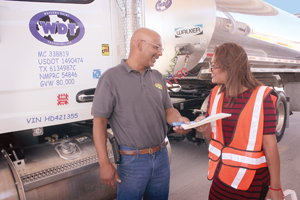Drive for the Prize

This story appears in the February 6 print edition of iTECH, a supplement to Transport Topics.
As the trucking industry continues to grapple with high driver turnover, some carriers are turning to performance-based rewards and technology-enabled “gamification” programs to increase driver retention and boost engagement.
Encouraging friendly competition also enhances safety and improves the bottom line, fleets and technology providers said.
On Jan. 1, refrigerated carrier C.R. England Inc. rolled out a gamification program that awards points to drivers monthly for safety, fuel efficiency, on-time performance and total drive hours. Drivers also can earn additional points for completing online training or selection as driver of the quarter or the year.
BEST OF FEBRUARY iTECH: More stories, columns
“There is a leaderboard, and drivers can see how they rank against their peers in their fleet and across the company,” said Mitch England, vice president of driver relations for the Salt Lake City-based carrier. “The beauty for the drivers is to be able to see an objective measurement of their performance. We hope it will be fun, too.”
Drivers can redeem points in an online store for products as they progress through different status levels.
“We patterned it after Delta SkyMiles,” England said. “As drivers earn points, they can reach bronze, gold and platinum. They’ll be recognized and given a hat and a pin.”
C.R. England ranks No. 23 on the Transport Topics Top 100 list of the largest for-hire carriers in the United States and Canada.
Receiving recognition for a job well done “ties into our human need for positive affirmation,” said Tim Hindes, CEO at Stay Metrics, which offers rewards and a recognition platform focused on driver retention.
Prizes can make more effective rewards than cash bonuses, he said.
“When drivers get $10 extra on their settlement for a safety or fuel achievement, it gets buried in there. That driver may not even realize he or she has been rewarded,” Hindes said, adding that a reward feels like a treat.
With Stay Metrics, carriers determine the level of funding they want to offer for driver rewards. The average is $500 per driver per year, which drivers can use to select from 40,000 items in the Stay Metrics catalog, he said.
Western Dairy Transport, based in Cabool, Missouri, uses Stay Metrics to reward each of its 500 drivers a maximum benefit of $1,200 in prizes per year.
The carrier uses the program to encourage drivers to compete against themselves, rather than other drivers, said David Shelton, Western Dairy Transport’s CEO.
He estimates that Stay Metrics has resulted in a 10% improvement in driver retention, adding that the program also provides safety benefits.
“We have a downward trend on liability and comp losses,” Shelton said.
About 80% of Western Dairy Transport’s drivers engage in the program. Among that group, between half and two-thirds reach the $1,200 maximum.
Shelton said there is a greater perceived value, dollar for dollar, than there would be for the cash equivalent. His drivers have purchased everything from a canoe to vacations. Some use it to buy gifts for their families.
Positive reinforcement is an important element of driver retention, said John Elliott II, CEO of Load One, a transportation and logistics provider based in Taylor, Michigan.
“While pay is an important part, it is only a piece of what drivers are looking for,” he said. “Recognition and appreciation have a sense of pride and trophy value that simple compensation cannot cover.”
Reducing turnover ultimately improves safety, Elliott said.
“Retained drivers have had more time and training invested in them already, so a more experienced, well-trained, senior workforce is almost always going to improve performance,” Elliott said. “While the program has a distinct line on a financial statement, the offset and benefits are truly spread out over the complete financial report.”
Several trucking technology suppliers have introduced products and features designed help fleets motivate and coach their drivers.
In December, Geotab began offering the Driver Challenge mobile app on its telematics platform.
That app, developed by d2go Solutions Inc., enables drivers to check their performance trends and see how they rank compared with their peers.
“It is designed to get drivers competing with each other,” said Louis-Philippe Papillon, lead software architect at d2go. “Now a driver knows at the end of the day, ‘Not only did I speed 12 times during the day,’ but how that compared to the other guys.”
Papillon said the information is updated in real time.
Fleets also can pull data directly from Geotab to create their own incentives, said Scott Sutarik, OEM business development manager at Geotab. The technology firm allows fleets to run reports, track specific metrics and send driver notifications if an exception occurs.
Overland Contracting Inc., a subsidiary of engineering firm Black & Veatch, uses its Geotab system to create weekly and monthly scorecards for drivers.
The program warns drivers who fall into a high-risk category so they can correct their behavior before it becomes an issue, said Matthew Bastian, telecom fleet manager for OCI.
Each month, Overland Contracting identifies its top five and bottom five drivers.
“Because we’re transparent about the whole thing, everybody sees everybody else’s score. If someone is doing horribly, they rag on each other. It self-regulates itself that way,” Bastian said.
Brad Taylor, vice president of data and internet of things solutions for Omnitracs, said his company’s fleet customers also are creating gamification programs to help drivers improve their performance.
“As a human being, the hardest thing to do is to look in the mirror and, without feedback, figure out what you’re doing right and what you’re doing wrong,” he said.
Fleets are also using gamification to reduce driver turnover.
“We want to retain drivers,” Taylor said. “When drivers are with fleets longer, they tend to be safer.”
Eric Witty, vice president of product management at PeopleNet, said the proliferation of consumer devices has made information more accessible to drivers.
“Now you’re pushing information to people’s phones and tablets,” he said. “It allows all of us to provide drivers with a sexier, real-time feedback of the metrics.”
PeopleNet provides data that show drivers’ performance as well as how they rate against their peers. Fleets can use the data to create their own incentives, Witty said.
SkyBitz also captures driver behavior data that can support gamification programs.
“Healthy competition is a good thing,” said Henry Popplewell, the company’s president.
Fleets are establishing standards and then rewarding drivers who exceed them, he said. “Rather than discipline, let’s reward.”
While best known for its trailer tracking products, SkyBitz also offers in-cab technology for local delivery vehicles through its SkyBitz Local Fleets division. That business unit monitors driving behaviors, such as speeding, and reports sudden movements, such as hard braking or hard acceleration.
SkyBitz works with customers to identify benchmarks they want to track. The firm also offers exception-based reporting when a driver is outside the norm. Fleets can use the data to select drivers of the month, quarter or year.
Interest in gamification and driver incentives is increasing, said Mark Wallin, vice president of product management at Telogis, a Verizon company.
“Programs that utilize these techniques achieve greater results,” he said.
Telogis offers driver scorecards that report factors such as safety, fuel efficiency, productivity, compliance and service time adherence.
“Some companies are very transparent and will share the names of who is on the top, in the middle and on the bottom. Some are not, and we obscure the names, but drivers know how they are doing with their peer group. Both achieve similar results,” Wallin said.
Vnomics offers real-time driver coaching as well as analytics related to fuel efficiency.
“[Fleets] use this to score their drivers, understand which drivers are wasting fuel and which are not, and then they can break them down into groups,” said Edward McCarthy, vice president of operations and customer success. “They use it to identify the best drivers and incent them.”
Fleets can use the fuel savings to increase pay or reward drivers, either through bonuses or prizes such as trips or extra time off.
“Some of our larger fleets have used the information to assign drivers the newest trucks or routes that best match their skills,” McCarthy said.
Netradyne, a provider of safety technology that captures and analyzes video, offers its GreenZone program, which scores drivers based on performance.
“It functions like a credit score,” said Adam Kahn, vice president of fleet business for Netradyne. “The conversations you can have with your driver fundamentally change. You’re not only pointing out the punitive opportunities. You have the opportunity to tell them that on 19 out of 20 days, they were a great driver,” he said.
If drivers finish the day with a perfect score, they receive a recognition notification.
“If you’re never given the opportunity to be recognized for your atta-boys and atta-girls, it is frustrating,” Kahn said.
Carriers and technology providers agreed that it is important for driver performance goals to be attainable.
C.R. England hopes its new gamification program will offer incentives to improve to all of its drivers, not just the best ones.
“We hope the people on the bottom will want to be on the top and work to get there,” England said. “Ultimately, we think it is a positive to create the friendly competition and the pride that comes through moving through the different status levels.” ³




